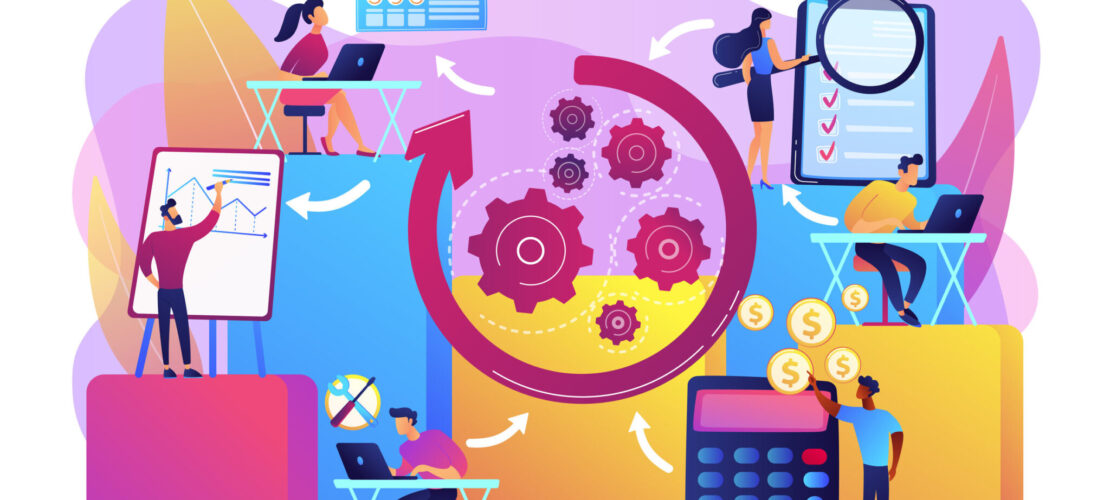
There’s a vast divide that continues to expand within today’s workforce. How we work, and the skills people need for businesses to compete, are changing fast. There are knowledge and skills gaps across all industries. And no business is immune.
Company leaders, HR, and Learning & Development teams are strategizing their upskilling and reskilling efforts. Technological advancement, AI, automation, and the dynamics of an agile work culture trigger the need for people to continuously learn.
Organizations that embrace an upskill and reskill strategy help employees’ skills and knowledge remain relevant. And businesses that grab ahold of investing in a learning culture will be prepared for market disruption, opportunities, and innovation.
According to an Adecco survey – 92% of business leaders think Americans aren’t as skilled as they need to be.
And it’s not all technical skills. It’s noted that 44% think Americans lack needed soft skills: communication, creativity, critical thinking, and collaboration.
Before Covid-19, business leaders were already reading the tea leaves and recognizing the current and impending need to integrate an upskill and reskill strategy in their operations. Then in early 2020, the pandemic hit like a fast-rising tide, changing our lives and economy forever.
There’s at least one critical lesson to learn in how we had to pivot in business – and where we work. It’s that organizations must prepare for future business needs. And this includes anticipating the skills needed for the future and aligning training efforts to reskill or upskill employees.
Even back in 2018, the World Economic Forum issued their Future of Jobs Report highlighting that 54% of all employees will need significant reskilling and upskilling by 2022.
Before we tackle how to bridge the divide, let’s first clarify upskill and reskill.
What’s the Difference Between Reskilling and Upskilling?
Reskilling involves the process of evaluating an individuals’ current skills and developing the training needed to take on a new position. This often entails identifying employees with somewhat similar skills and the aptitude, as well as the desire, to embrace learning for a new role.
Upskilling on the other hand, focuses on providing training for employees to learn new, advanced skills to close the gap between either their performance or the need to advance their career path. Efforts to upskill an employee usually involve remaining in their current role. Yet the training provides the opportunity to expand their capabilities, efficiency, learn new technologies, and personal growth. Thereby, both the organization and employee benefits.
Why Should Reskilling and Upskilling Matter?

Reskilling and upskilling should be a big deal to all organizations and every worker. There’s a significant difference in today’s jobs from even a generation earlier. And all of us, from Gen Zers to Boomers, should be cognizant that we’re living in a working world that is evolving fast, requires agility, and is more unpredictable than ever.
Next, let’s take a look at several benefits when an organization addresses upskilling and reskilling.
Career pathing
Most employees, no matter their role or industry, like to know that there is a path forward for them. If they like working for their current organization, having the opportunity to upskill or reskill reinforces their commitment to the company. Career pathing is important for everyone, not just high protentional and top-performing employees striving for the next leadership role. Everyone benefits from a crafted career path.
Succession planning
Successful companies plan for the future, growth, and new business endeavors. Having the right people in place is critical to that success. In a continuous learning culture whereby reskilling and upskilling is integral to business operations, organizational leaders can plan for succession of people. This provides stability for the organization and helps retain their valued staff.
Retention
Everyone wins when an organization has a high retention rate. A commitment to reskilling and upskilling are critical to retention. Organizations win because they are able to retain knowledgeable and skilled employees. As well, it is fiscally beneficial to retain and develop your people rather than have a revolving front door and constantly hiring to replace valuable talent. When employees have access to upskilling or reskilling, they are more likely to stay with the organization.
Increased remote work
Even before the onslaught of the pandemic, companies and employees discovered the benefits of remote work. However, the urgency to pivot in early 2020 towards a greater remote working environment shined a light on the need to upskill and reskill employees, both in technical skills and soft skills. Much of remote work positions will remain even after the end of Covid. Therefore, it’s important for organizations to continue with their upskill and reskill efforts.
Advancing technologies
New technologies, including AI, create tremendous opportunities for businesses to grow, improve efficiency, and innovate. Yet, technology can also create skills gaps – often cavernous ones – between employees and the capabilities of the technology. It is only through upskilling and reskilling training efforts that organizations can maximize the use and availability of technology.
So far, we’ve looked at the need and benefits of an upskill and reskill strategy. Now let’s focus on some best practices, specifically involving reskilling.
Best Practices to Reskilling Employees
In today’s dynamic work environment, employees should always be learning. Ideally, their employer surrounds them with a culture of continuous learning. Some training might be to bridge gaps between current skills and needed skills. Likewise, many individuals just have a desire to learn through their own initiative.
But what happens when an employee needs reskilling to shift or grow into a new role?
Sometimes it is their choice to change roles. Other times, reskilling is necessary to retain a position in the organization or is of great need. So, what’s the first step for organizational leaders in reskilling?
The first step in reskilling is to determine where an employee’s passions lie. A complete shift in an employee’s industry skillset may be something that leaders want or need. However, if it doesn’t align with the employee’s aspirations, then reskilling efforts and creating a different career path is pointless.
Leaders should spend time understanding what their employees are passionate about. How do they think they can most positively impact the business where both they and the business can benefit long term?
Leaders should spend time to find out what they like to “build” and see if that aligns with the corporate goals and initiatives of the business. Once this is determined, then the next step is to develop a career path, coupled with a training development pathway.
Here’s some tips for leaders to help employees adapt and develop into new roles as part of reskilling.
Don’t set timelines for when employees need to be “fully trained.” These expectations are often unrealistic and create unnecessary pressure for the employee to know or do something. This will come naturally with time.
Create an atmosphere that allows people to regularly communicate their needs. A solid communication infrastructure allows employees to escalate issues as needed rather than leaders telling employees what to do. The best leaders provide vision rather than instruction.
As part of reskilling, pair employees with people that can create a collaborative environment to solve problems and get work done. Leaders should encourage employees to network outside of their immediate circles. It will be helpful to keep their “finger on the pulse” of the industry.
Leaders should stress the importance of being excellent, not perfect. Doing nothing, while pursuing perfection, is a quick way to be non-competitive in an extremely competitive marketspace. More and more, people are less concerned with the details. Rather they are looking for the overall message and how it impacts them.
Identifying the Skills Gap for a Continuous Learning Workforce

The demand for skilled talent will only continue to grow. As technology advances and disruptions occur, the skills gap will only widen.
In today’s workplace, it’s imperative for the people to continuously learn and sharpen their skill set to stay relevant and pursue a career path.
The new reality is that for businesses and the workforce to survive, they must embark on a reskilling and upskilling strategy. The organizations that will excel are those who can accurately identify what skills are needed for the future, outline the current skills gap, and tailor a continuous learning program that best fits the needs of their workforce.
However, according to a recent Deloitte survey, most organizations don’t have the insights to get started with an upskilling and reskilling initiative.
Fifty-nine percent said they need additional information to understand the readiness of their workforce to meet demands.
And 38% indicated that identifying workforce development needs and priorities is their greatest barrier to workforce development.
At RTG Solutions Group, we recommend starting with a training needs analysis.
By identifying the current skills of employees and mapping out needed skills for upskilling or reskilling, our consultants outline the gaps in the skills and the necessary training and development to bridge the gap. Many organizations don’t know where to start. Our proven training analysis process clearly outlines the gaps and creates a roadmap to get the organization where it needs to be.
Bridging the Skills Gap with Soft Skills
The needed skills to upskill or reskill employees can take multiple forms. Many are technical, as it relates to new software or technology. However, do not overlook soft skills, as, well – soft. The descriptor for soft skills as something subtle, malleable, or even weak is just misleading and inaccurate.
According to an ATD survey, the top concerns for hiring managers across all industries are soft skills. Specifically, today’s employees need training in:
- Communication and interpersonal skills
- Critical thinking and problem-solving
- Managerial and supervisory skills
- Leadership skills
- Process improvement and project management
- Creativity and innovation
A PWC survey reported in 2020 that 74% of CEOs were worried about the lack of essential skills among employees. Specifically, they believe that the biggest threat to their businesses stems from underdeveloped soft skills.
Lack of soft skills if often most noted among the Gen Zers and Millennials. As digital natives, they intuitively adapt to technology and software. Additionally, they can quickly learning new systems without fear or hesitation.
However, business leaders are recognizing their lack of important soft skills such as communications and teamwork.
But let’s not just single out the valued Millennials and Gen Zers. All generations need to continue to hone and upskill their soft skills.
However, the lack of soft skills among younger workers can inhibit succession planning and career development.
Despite the sometimes “soft” stigma of soft skills, the message from business leaders across all industries is clear. In order to compete, grow, and innovate, we must address upskilling our people with soft skills across all levels of the organization.
Conclusion
Every organization, in every industry, is vulnerable to the gap between their people’s skills and what is needed for their business to remain agile and competitive.
The first step is acknowledging the skills gap.
Second, accurately assess the skills needed to bridge the divide.
Third, develop and implement upskill and reskill efforts as part of employee training and development program.
And lastly, show a commitment to a continuous learning culture across the organization.
Leaders must be genuine in their dedication to train, upskill, reskill, and develop their people. Afterall, it is a true win-win. The benefits are many, including, career pathing, succession planning, employee retention, adaptability to remote work, and ability to embrace advancing technologies.
Remember, it’s important for organizations to strike the balance between soft and hard skills to maintain a competitive advantage. A comprehensive needs assessment will bring to light the skills gaps. A upskill and reskill strategy will provide the framework to bridge the skills gap divide.
Leaders, the data is evident. A skilled and knowledge workforce within a continuous learning culture will position your organization for growth, innovation, and a competitive advantage.
If your team is looking to measure your skills gap and develop a upskill and reskill strategy, our Learning and Development consultants can help. RTG Solutions Group is committed to helping businesses assess their needs and implement a comprehensive learning and development program. Contact us today.
